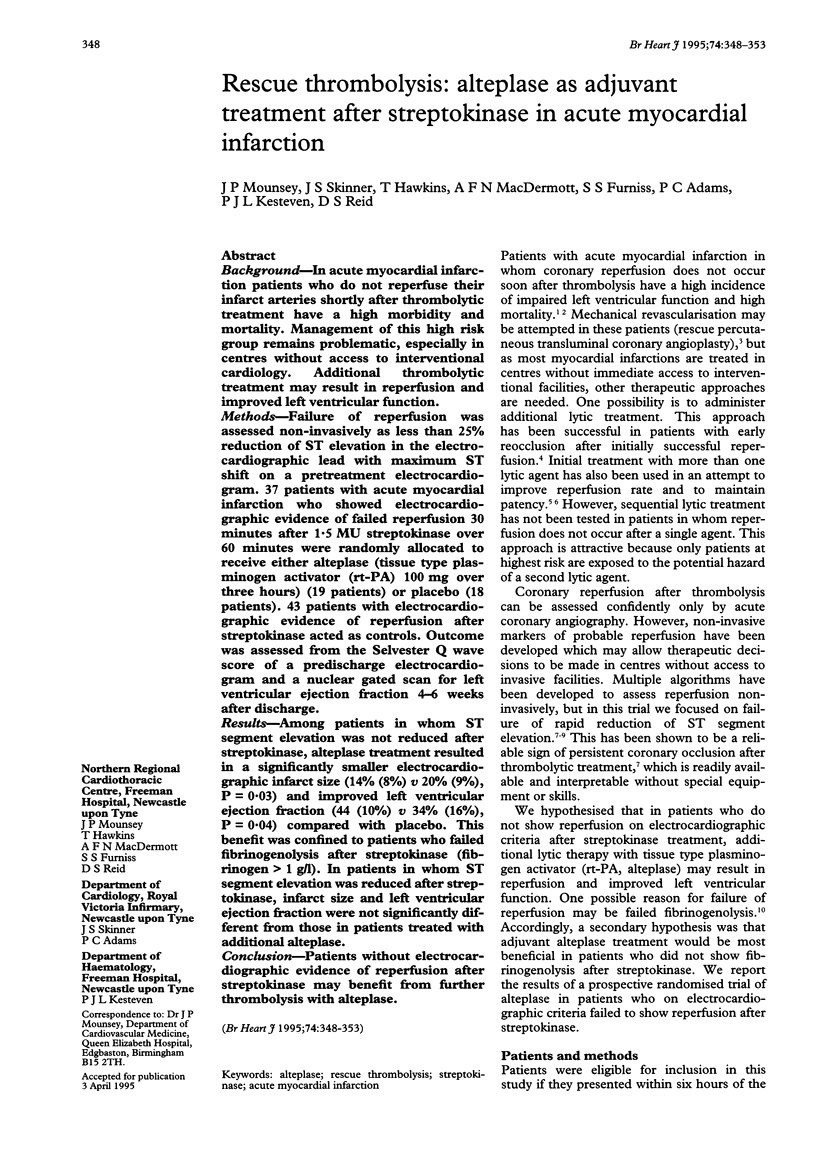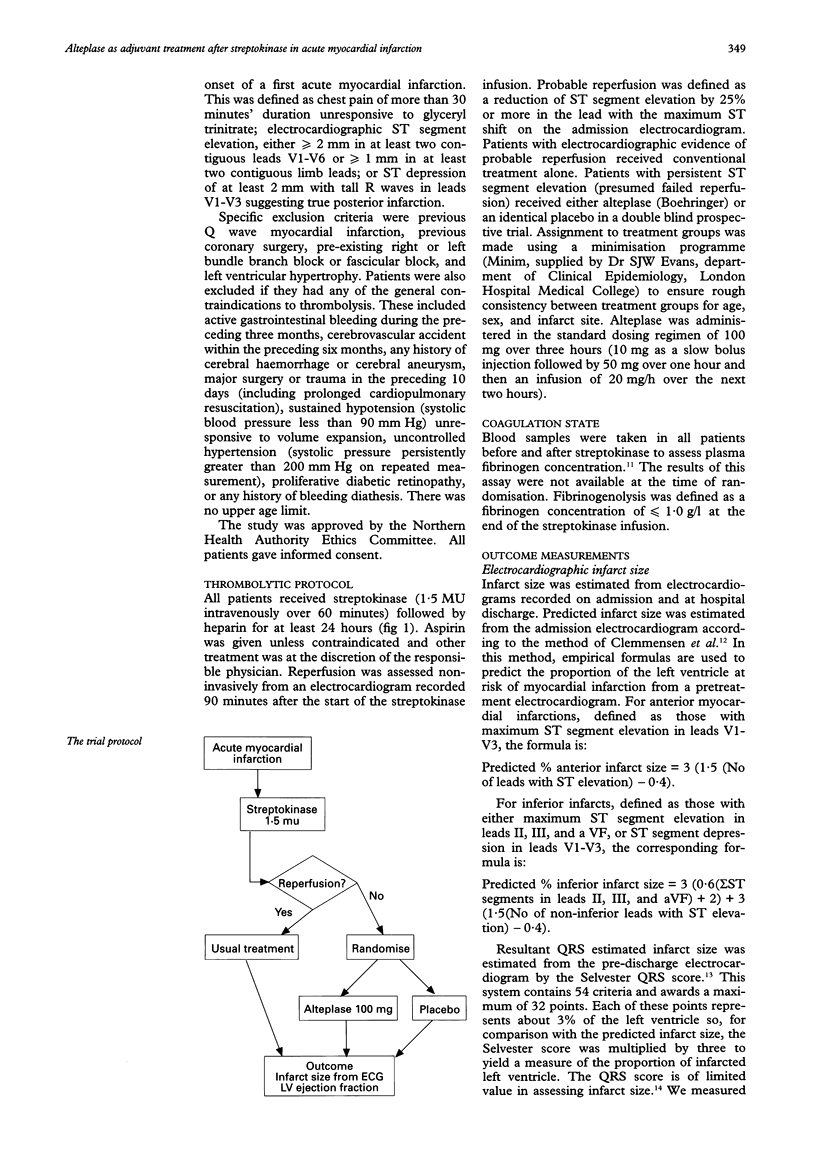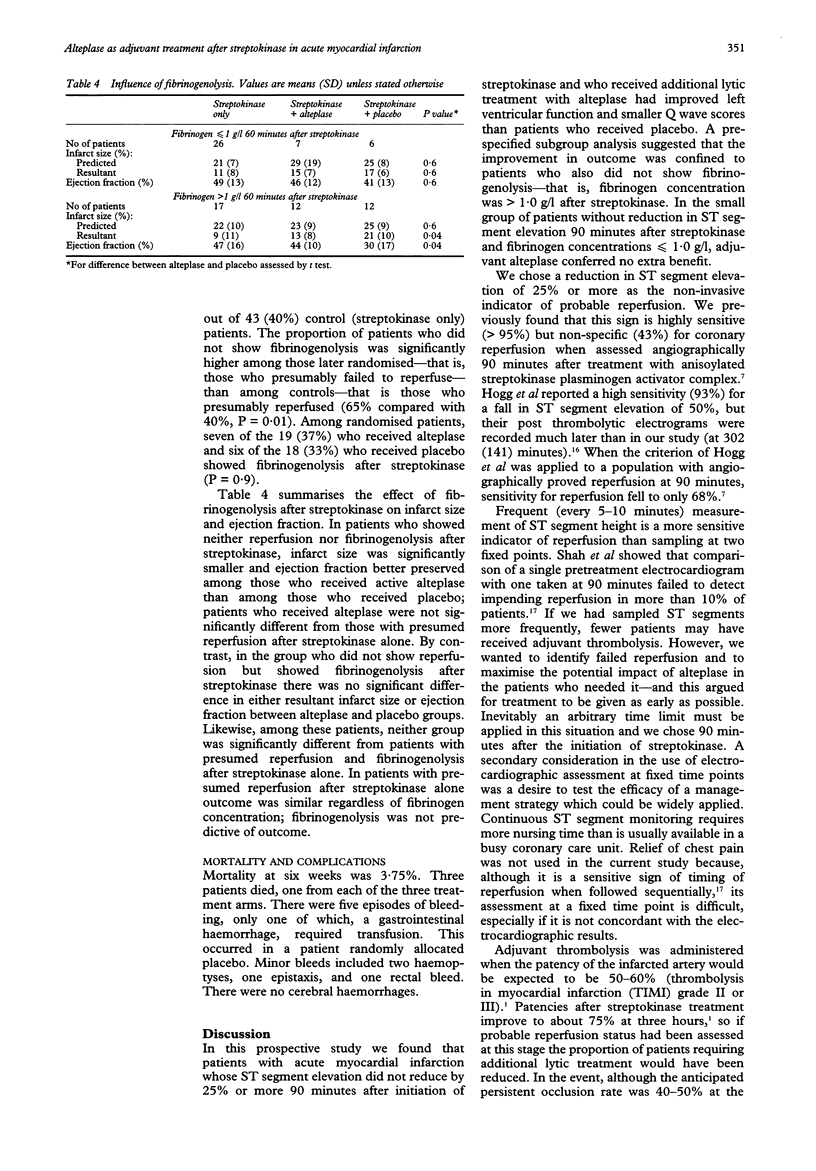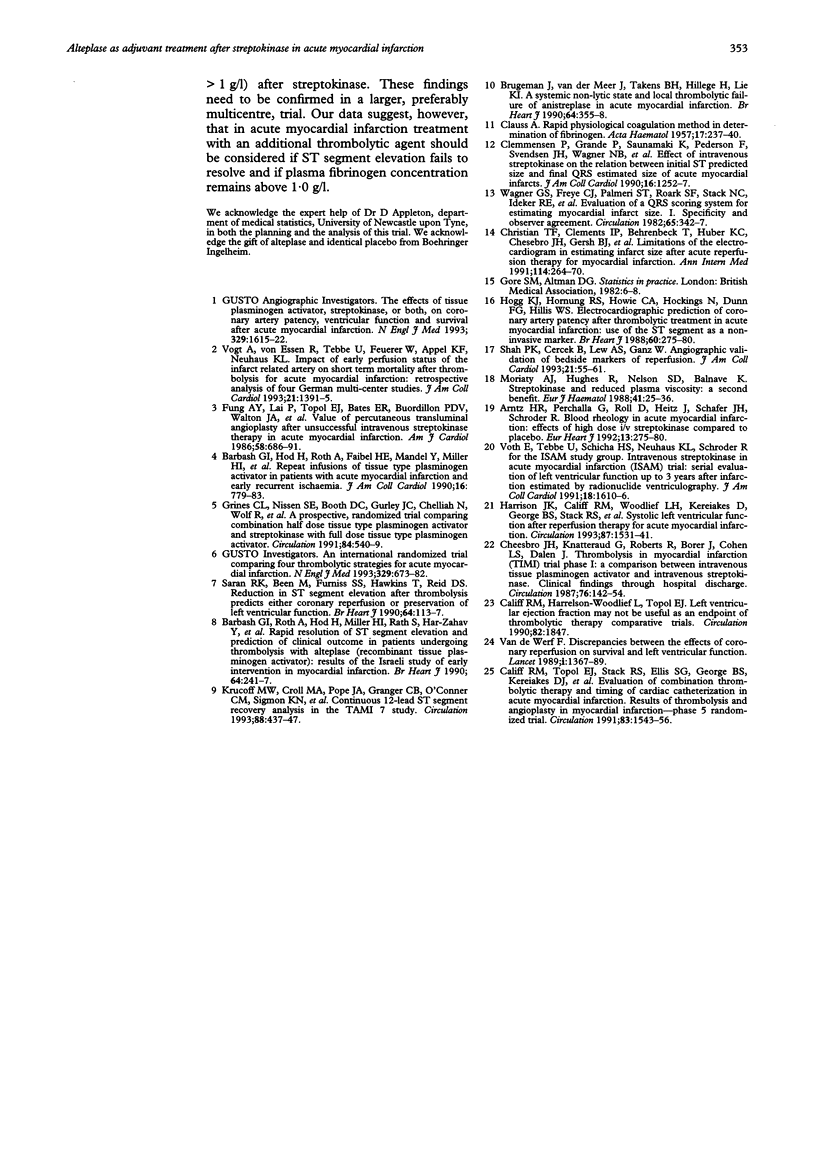Abstract
BACKGROUND--In acute myocardial infarction patients who do not reperfuse their infarct arteries shortly after thrombolytic treatment have a high morbidity and mortality. Management of this high risk group remains problematic, especially in centres without access to interventional cardiology. Additional thrombolytic treatment may result in reperfusion and improved left ventricular function. METHODS--Failure of reperfusion was assessed non-invasively as less than 25% reduction of ST elevation in the electrocardiographic lead with maximum ST shift on a pretreatment electrocardiogram. 37 patients with acute myocardial infarction who showed electrocardiographic evidence of failed reperfusion 30 minutes after 1.5 MU streptokinase over 60 minutes were randomly allocated to receive either alteplase (tissue type plasminogen activator (rt-PA) 100 mg over three hours) (19 patients) or placebo (18 patients). 43 patients with electrocardiographic evidence of reperfusion after streptokinase acted as controls. Outcome was assessed from the Selvester Q wave score of a predischarge electrocardiogram and a nuclear gated scan for left ventricular ejection fraction 4-6 weeks after discharge. RESULTS--Among patients in whom ST segment elevation was not reduced after streptokinase, alteplase treatment resulted in a significantly smaller electrocardiographic infarct size (14% (8%) v 20% (9%), P = 0.03) and improved left ventricular ejection fraction (44 (10%) v 34% (16%), P = 0.04) compared with placebo. This benefit was confined to patients who failed fibrinogenolysis after streptokinase (fibrinogen > 1 g/l). In patients in whom ST segment elevation was reduced after streptokinase, infarct size and left ventricular ejection fraction were not significantly different from those in patients treated with additional alteplase. CONCLUSION--Patients without electrocardiographic evidence of reperfusion after streptokinase may benefit from further thrombolysis with alteplase.
Full text
PDF





Selected References
These references are in PubMed. This may not be the complete list of references from this article.
- Arntz H. R., Perchalla G., Roll D., Heitz J., Schäfer J. H., Schröder R. Blood rheology in acute myocardial infarction: effects of high-dose i.v. streptokinase compared to placebo. Eur Heart J. 1992 Feb;13(2):275–280. doi: 10.1093/oxfordjournals.eurheartj.a060159. [DOI] [PubMed] [Google Scholar]
- Barbash G. I., Hod H., Roth A., Faibel H. E., Mandel Y., Miller H. I., Rath S., Zahav Y. H., Rabinowitz B., Seligsohn U. Repeat infusion of recombinant tissue-type plasminogen activator in patients with acute myocardial infarction and early recurrent myocardial ischemia. J Am Coll Cardiol. 1990 Oct;16(4):779–783. doi: 10.1016/s0735-1097(10)80321-3. [DOI] [PubMed] [Google Scholar]
- Barbash G. I., Roth A., Hod H., Miller H. I., Rath S., Har-Zahav Y., Modan M., Seligsohn U., Battler A., Kaplinsky E. Rapid resolution of ST elevation and prediction of clinical outcome in patients undergoing thrombolysis with alteplase (recombinant tissue-type plasminogen activator): results of the Israeli Study of Early Intervention in Myocardial Infarction. Br Heart J. 1990 Oct;64(4):241–247. doi: 10.1136/hrt.64.4.241. [DOI] [PMC free article] [PubMed] [Google Scholar]
- Brügemann J., van der Meer J., Takens B. H., Hillege H., Lie K. I. A systemic non-lytic state and local thrombolytic failure of anistreplase (anisoylated plasminogen streptokinase activator complex, APSAC) in acute myocardial infarction. Br Heart J. 1990 Dec;64(6):355–358. doi: 10.1136/hrt.64.6.355. [DOI] [PMC free article] [PubMed] [Google Scholar]
- CLAUSS A. Gerinnungsphysiologische Schnellmethode zur Bestimmung des Fibrinogens. Acta Haematol. 1957 Apr;17(4):237–246. doi: 10.1159/000205234. [DOI] [PubMed] [Google Scholar]
- Califf R. M., Harrelson-Woodlief L., Topol E. J. Left ventricular ejection fraction may not be useful as an end point of thrombolytic therapy comparative trials. Circulation. 1990 Nov;82(5):1847–1853. doi: 10.1161/01.cir.82.5.1847. [DOI] [PubMed] [Google Scholar]
- Califf R. M., Topol E. J., Stack R. S., Ellis S. G., George B. S., Kereiakes D. J., Samaha J. K., Worley S. J., Anderson J. L., Harrelson-Woodlief L. Evaluation of combination thrombolytic therapy and timing of cardiac catheterization in acute myocardial infarction. Results of thrombolysis and angioplasty in myocardial infarction--phase 5 randomized trial. TAMI Study Group. Circulation. 1991 May;83(5):1543–1556. doi: 10.1161/01.cir.83.5.1543. [DOI] [PubMed] [Google Scholar]
- Chesebro J. H., Knatterud G., Roberts R., Borer J., Cohen L. S., Dalen J., Dodge H. T., Francis C. K., Hillis D., Ludbrook P. Thrombolysis in Myocardial Infarction (TIMI) Trial, Phase I: A comparison between intravenous tissue plasminogen activator and intravenous streptokinase. Clinical findings through hospital discharge. Circulation. 1987 Jul;76(1):142–154. doi: 10.1161/01.cir.76.1.142. [DOI] [PubMed] [Google Scholar]
- Christian T. F., Clements I. P., Behrenbeck T., Huber K. C., Chesebro J. H., Gersh B. J., Gibbons R. J. Limitations of the electrocardiogram in estimating infarction size after acute reperfusion therapy for myocardial infarction. Ann Intern Med. 1991 Feb 15;114(4):264–270. doi: 10.7326/0003-4819-114-4-264. [DOI] [PubMed] [Google Scholar]
- Clemmensen P., Grande P., Saunamäki K., Pedersen F., Svendsen J. H., Wagner N. B., Granborg J., Madsen J. K., Haedersdal C., Wagner G. S. Effect of intravenous streptokinase on the relation between initial ST-predicted size and final QRS-estimated size of acute myocardial infarcts. J Am Coll Cardiol. 1990 Nov;16(5):1252–1257. doi: 10.1016/0735-1097(90)90562-4. [DOI] [PubMed] [Google Scholar]
- Fung A. Y., Lai P., Topol E. J., Bates E. R., Bourdillon P. D., Walton J. A., Mancini G. B., Kryski T., Pitt B., O'Neill W. W. Value of percutaneous transluminal coronary angioplasty after unsuccessful intravenous streptokinase therapy in acute myocardial infarction. Am J Cardiol. 1986 Oct 1;58(9):686–691. doi: 10.1016/0002-9149(86)90338-3. [DOI] [PubMed] [Google Scholar]
- Grines C. L., Nissen S. E., Booth D. C., Gurley J. C., Chelliah N., Wolf R., Blankenship J., Branco M. C., Bennett K., DeMaria A. N. A prospective, randomized trial comparing combination half-dose tissue-type plasminogen activator and streptokinase with full-dose tissue-type plasminogen activator. Kentucky Acute Myocardial Infarction Trial (KAMIT) Group. Circulation. 1991 Aug;84(2):540–549. doi: 10.1161/01.cir.84.2.540. [DOI] [PubMed] [Google Scholar]
- Harrison J. K., Califf R. M., Woodlief L. H., Kereiakes D., George B. S., Stack R. S., Ellis S. G., Lee K. L., O'Neill W., Topol E. J. Systolic left ventricular function after reperfusion therapy for acute myocardial infarction. Analysis of determinants of improvement. The TAMI Study Group. Circulation. 1993 May;87(5):1531–1541. doi: 10.1161/01.cir.87.5.1531. [DOI] [PubMed] [Google Scholar]
- Hogg K. J., Hornung R. S., Howie C. A., Hockings N., Dunn F. G., Hillis W. S. Electrocardiographic prediction of coronary artery patency after thrombolytic treatment in acute myocardial infarction: use of the ST segment as a non-invasive marker. Br Heart J. 1988 Oct;60(4):275–280. doi: 10.1136/hrt.60.4.275. [DOI] [PMC free article] [PubMed] [Google Scholar]
- Krucoff M. W., Croll M. A., Pope J. E., Granger C. B., O'Connor C. M., Sigmon K. N., Wagner B. L., Ryan J. A., Lee K. L., Kereiakes D. J. Continuous 12-lead ST-segment recovery analysis in the TAMI 7 study. Performance of a noninvasive method for real-time detection of failed myocardial reperfusion. Circulation. 1993 Aug;88(2):437–446. doi: 10.1161/01.cir.88.2.437. [DOI] [PubMed] [Google Scholar]
- Moriarty A. J., Hughes R., Nelson S. D., Balnave K. Streptokinase and reduced plasma viscosity: a second benefit. Eur J Haematol. 1988 Jul;41(1):25–36. doi: 10.1111/j.1600-0609.1988.tb00865.x. [DOI] [PubMed] [Google Scholar]
- Saran R. K., Been M., Furniss S. S., Hawkins T., Reid D. S. Reduction in ST segment elevation after thrombolysis predicts either coronary reperfusion or preservation of left ventricular function. Br Heart J. 1990 Aug;64(2):113–117. doi: 10.1136/hrt.64.2.113. [DOI] [PMC free article] [PubMed] [Google Scholar]
- Shah P. K., Cercek B., Lew A. S., Ganz W. Angiographic validation of bedside markers of reperfusion. J Am Coll Cardiol. 1993 Jan;21(1):55–61. doi: 10.1016/0735-1097(93)90716-e. [DOI] [PubMed] [Google Scholar]
- Van de Werf F. Discrepancies between the effects of coronary reperfusion on survival and left ventricular function. Lancet. 1989 Jun 17;1(8651):1367–1369. doi: 10.1016/s0140-6736(89)92812-2. [DOI] [PubMed] [Google Scholar]
- Vogt A., von Essen R., Tebbe U., Feuerer W., Appel K. F., Neuhaus K. L. Impact of early perfusion status of the infarct-related artery on short-term mortality after thrombolysis for acute myocardial infarction: retrospective analysis of four German multicenter studies. J Am Coll Cardiol. 1993 May;21(6):1391–1395. doi: 10.1016/0735-1097(93)90314-q. [DOI] [PubMed] [Google Scholar]
- Voth E., Tebbe U., Schicha H., Neuhaus K. L., Schröder R. Intravenous streptokinase in acute myocardial infarction (I.S.A.M.) trial: serial evaluation of left ventricular function up to 3 years after infarction estimated by radionuclide ventriculography. I.S.A.M. Study Group. J Am Coll Cardiol. 1991 Dec;18(7):1610–1616. doi: 10.1016/0735-1097(91)90492-r. [DOI] [PubMed] [Google Scholar]
- Wagner G. S., Freye C. J., Palmeri S. T., Roark S. F., Stack N. C., Ideker R. E., Harrell F. E., Jr, Selvester R. H. Evaluation of a QRS scoring system for estimating myocardial infarct size. I. Specificity and observer agreement. Circulation. 1982 Feb;65(2):342–347. doi: 10.1161/01.cir.65.2.342. [DOI] [PubMed] [Google Scholar]


